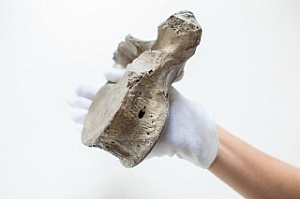TSU has received the most famous mammoth bone in the world to be struck by the spear of an ancient human. The vertebra, pierced by a metal weapon, is about 16,200 years old. Paleontologists plan to take several milligrams of bone to extract the mammoth DNA. In joint research with colleagues from Poland, it may be possible to obtain data on the presence of various diseases in late mammoths. The unique exhibit will be at TSU until the end of 2018, under a contract with the Khanty-Mansiysk Museum of Nature and the Human.
The thoracic vertebra of an adult mammoth (Mammuthus primigenius) was found in 2002 at Lugovskoye in the Khanty-Mansi Autonomous Okrug, and since then it has been kept in the Museum of Nature and the Human. The journey of the vertebra to Tomsk pursues a scientific goal: Tomsk scientists intend to carry out a series of studies to define the micro-architecture of the mammoth's bone tissue more precisely, to determine the presence of diseases in it, and to obtain information about the genetic characteristics of the ancient animal.
Scientists also call this finding “the Mona Lisa of geoarchaeology”: this is the first real evidence in Asia and the best in the world of ancient humans hunting a mammoth. In the body of the vertebra is an oval hole left by an ancient implement (presumably a spear). And the bone itself has jammed fragments of the tip: inserts of light green quartzite. There are no signs of healing, which indicates a fatal wound.
- This is a very valuable sample, and we hope that the results of paleo-DNA analysis will provide new information on the ecology of mammoths in the period of their mass extinction. But it is not certain that the DNA will be of a good quality: the ancient bones give less than 20% successful samples because they have been weathered and destroyed for thousands of years, - comments Sergey Leshchinsky, head of TSU's Laboratory of Mesozoic and Cenozoic Continental Ecosystems.
In 2002, he participated in excavations in which the vertebra was discovered.
- In addition, we plan to conduct synchrotron studies, a very detailed tomography, - explains Sergey Leshchinsky. They are needed so that, without destroying the sample, one can see the micro-architecture of the bone tissue and the zone of destruction. We carried out studies of this kind, only with a much smaller resolution - and it turned out that the animal suffered from osteoporosis. But the equipment did not allow going further and seeing the smallest details of the pathological process.
Tomsk scientists plan to allocate the paleo-DNA with their colleagues from Poland. The necessary synchrotron studies of the vertebra are the closest that are geographically possible in Europe.

